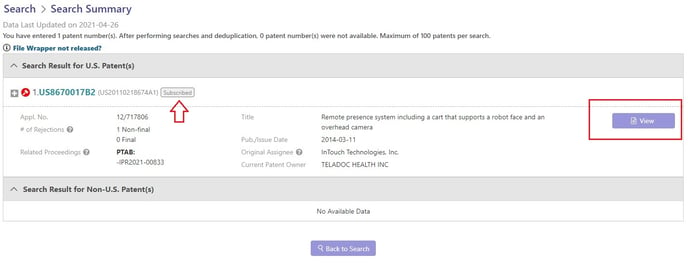What’s In QI
Whether purchased or not, entering a patent number or patent numbers on Quality Insights will lead you to Search Summary. On this page, information such as Application Number, Title, # of Rejections, Publication/ Issue Date, Original/ Current Assignee and its Related Proceedings is listed.
Whenever a “hammer” is seen next to the patent number, the patent has been involved in a US litigation case within 60 days. To see more of the US litigation cases, please visit Litigation Daily on the InQuartik website at https://www.inquartik.com/litigation-daily/.

Once the report is paid for, you'll see it is purchased and ready for View. It’s valid for one calendar year from the date of your purchase. “Start using Quality Insights”.
You are always welcome to subscribe to our QI's two level's subscription and enjoy unlimited access to QI report within the subscribed period.
Congratulations! You now can access the QI data below, which are highly relevant and important to the patent at issue for the purpose of invalidity or quality identification.
I. Overview includes three summaries: “Event History”, “Family Status”, and “Prior Art”.
The summary of Event History outlines a timeline with the patent’s prosecution and post grant events with double patenting, 102, 103 and pertinent patents as prior art references, and history summary of each event corresponding to File Wrapper Search.
The summary of Family Status uses a bar chart outlining the number of patent applications in each current category of legal status such as Abandoned, Active, Pending, and Others.
The summary of Prior Art applies a bar chart describing the number of patent applications in each type of art, such as Rejection Prior Art in Event History, Family Prior Art, Prior Art Finder and Semantic Prior Art.
II. Claim Analysis, for intrinsic evidence of claim construction, breaks down each claim where claim terms or keywords or phrases are identified with highlighters in comparison with spec.
III. Claim Insights, for file wrapper as intrinsic evidence of claim construction, breaks down each claim by elements, where keywords or phrases are identified with highlighters in comparison with those mentioned by examiners or petitioners in corresponding office actions of prior art.
IV. Family Prior Art lists all the other family members and their backward citations and examiners’ rejections as to patents and non-patent literature.
V. Prior Art Finder includes relevant prior art derived from the First Degree (Prior) Art, ie. (prior) art of the patent at issue, and the Second Degree Art, which is the prior art of the First Degree Art reference. It can go on up to the Sixth Degree Art. Three types of subsequent art: prior art’s prior art (backward - backward,) prior art’s subsequent art (backward - forward ), and subsequent art’s prior art (forward -second).
VI. Semantic Prior Art displays top 300 prior art references from the US, EP, JP, CN, KR and WO ranked by the relevance of the abstracts and claims of patents based on Patentcloud’s proprietary AI algorithm.
VII. File Wrapper Search provides text-searchable file wrappers in prosecution history and post-grant proceedings. They are only major file wrappers incorporated and updated, including non-final rejection (CTNF,) final rejection (CTFR,) original claims (CLM,) applicant arguments/remarks made in an amendment (REM/CLM,) notice of allowance (NOA,) terminal disclaimer filed (DIST,) and request for continued examination (RCE,) the requests (or petition,) determinations (or decision of institution,) patent owners' remarks (or response,) and certificates (or final decision) in reexamination (or IPR, CBM and PGR patent reviews,) as well as complaints, their attachments, orders, and final on violation as per ITC case numbers.